
Amorphophallus is a large genus of some 200 tropical and subtropical tuberous herbaceous plants from the Arum family (Araceae), native to Asia, Africa, Australia and various oceanic islands. A few species are edible as "famine foods" after careful preparation to remove irritating chemicals. The genus includes the Titan arum of Indonesia, which has the largest inflorescence of any plant in the genus, and is also known as the 'corpse flower' for the pungent odour it produces during its flowering period, which can take up through seven years of growth before it occurs.

Mangosteen, also known as the purple mangosteen, is a tropical evergreen tree with edible fruit native to tropical lands surrounding the Indian Ocean. Its origin is uncertain due to widespread prehistoric cultivation. It grows mainly in Southeast Asia, southwest India and other tropical areas such as Colombia and Puerto Rico, where the tree has been introduced.

Taxodium distichum is a deciduous conifer in the family Cupressaceae. It is native to the southeastern United States. Hardy and tough, this tree adapts to a wide range of soil types, whether wet, salty, dry, or swampy. It is noted for the russet-red fall color of its lacy needles.

Ziziphus mauritiana, also known as Indian jujube, Indian plum, Chinese date, Chinee apple, ber and dunks is a tropical fruit tree species belonging to the family Rhamnaceae. It is often confused with the closely related Chinese jujube, but whereas Z. jujuba prefers temperate climates, Z. mauritiana is tropical to subtropical.
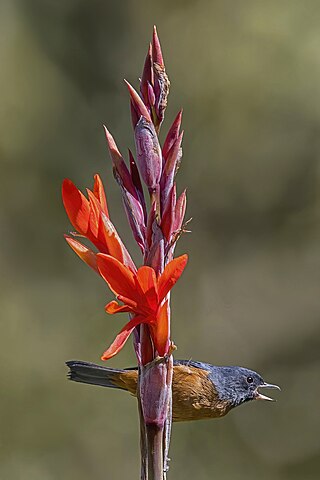
Canna indica, commonly known as Indian shot, African arrowroot, edible canna, purple arrowroot, Sierra Leone arrowroot, is a plant species in the family Cannaceae. It is native to much of South America, Central America, the West Indies, and Mexico. It is also naturalized in the southeastern United States, and much of Europe, sub-Saharan Africa, Southeast Asia, and Oceania. Canna indica has been a minor food crop cultivated by indigenous peoples of the Americas for thousands of years.

Plantago major, the broadleaf plantain, white man's footprint, waybread, or greater plantain, is a species of flowering plant in the plantain family Plantaginaceae. The plant is native to Eurasia.

Fuchsia excorticata, commonly known as tree fuchsia, New Zealand fuchsia and by its Māori name kōtukutuku, is a New Zealand native tree belonging to the family Onagraceae. It is commonly found throughout New Zealand and as far south as the Auckland Islands. It grows from sea level up to about 1,000 m (3,300 ft), particularly alongside creeks and rivers. It is easily recognised in its native environment by the characteristic appearance of its bark, which peels spontaneously, hanging in red papery strips to show a pale bark underneath. Its scientific name, excorticata, reflects this distinctive property.

Banksia serrata, commonly known as the saw banksia, the old man banksia, the saw-tooth banksia or the red honeysuckle and as wiriyagan by the Cadigal people, is a species of woody shrub or tree of the genus Banksia, in the family Proteaceae. Native to the east coast of Australia, it is found from Queensland to Victoria with outlying populations on Tasmania and Flinders Island. Commonly growing as a gnarled tree up to 16 m (50 ft) in height, it can be much smaller in more exposed areas. This Banksia species has wrinkled grey bark, shiny dark green serrated leaves and large yellow or greyish-yellow flower spikes appearing over summer. The flower spikes, or inflorescences, turn grey as they age and pollinated flowers develop into large, grey, woody seed pods called follicles.

Corypha umbraculifera, the talipot palm, is a species of palm native to eastern and southern India and Sri Lanka. It is also grown in Cambodia, Myanmar, Thailand and the Andaman Islands. It is a flowering plant with the largest inflorescence in the world. It lives up to 60 years before bearing flowers and fruits. It dies shortly after.

Spiranthes spiralis, commonly known as autumn lady's-tresses, is an orchid that grows in Europe and adjacent North Africa and Asia. It is a small grey-green plant. It forms a rosette of four to five pointed, sessile, ovate leaves about 3 cm (1.2 in) in length. In late summer an unbranched stem of about 10–15 cm (3.9–5.9 in) tall is produced with approximately four sheath-shaped leaves. The white flowers are about 5 mm (0.20 in) long and have a green spot on the lower lip. They are arranged in a helix around the upper half of the stalk. The species is listed in Appendix II of CITES as a species that is not currently threatened with extinction but that may become so. Autumn lady's-tresses are legally protected in Belgium and the Netherlands.

Banksia canei, commonly known as the mountain banksia, is a species of shrub that is endemic to southeastern Australia. It is generally encountered as a many-branched shrub that grows up to 3 m (10 ft) high, with narrow leaves and the yellow inflorescences appearing from late summer to early winter. The old flowers fall off the spikes and up to 150 finely furred follicles develop, which remain closed until burnt in a bushfire. Each follicle bears two winged seeds. Response to fire is poorly known, although it is thought to regenerate by seed. Birds such as the yellow-tufted honeyeater and various insects forage among the flower spikes. It is frost tolerant in cultivation, but copes less well with aridity or humidity and is often short-lived in gardens. One cultivar, Banksia 'Celia Rosser', was registered in 1978, but has subsequently vanished.

Banksia oblongifolia, commonly known as the fern-leaved, dwarf or rusty banksia, is a species in the plant genus Banksia. Found along the eastern coast of Australia from Wollongong, New South Wales in the south to Rockhampton, Queensland in the north, it generally grows in sandy soils in heath, open forest or swamp margins and wet areas. A many-stemmed shrub up to 3 m (9.8 ft) high, it has leathery serrated leaves and rusty-coloured new growth. The yellow flower spikes, known as inflorescences, most commonly appear in autumn and early winter. Up to 80 follicles, or seed pods, develop on the spikes after flowering. Banksia oblongifolia resprouts from its woody lignotuber after bushfires, and the seed pods open and release seed when burnt, the seed germinating and growing on burnt ground. Some plants grow between fires from seed shed spontaneously.

Banksia speciosa, commonly known as the showy banksia, is a species of large shrub or small tree in the family Proteaceae. It is found on the south coast of Western Australia between Hopetoun (33°57′ S) and the Great Australian Bight, growing on white or grey sand in shrubland. Reaching up to 8 m (26 ft) in height, it is a single-stemmed plant that has thin leaves with prominent triangular "teeth" along each margin, which are 20–45 cm (7.9–17.7 in) long and 2–4 cm (0.8–1.6 in) wide. The prominent cream-yellow flower spikes known as inflorescences appear throughout the year. As they age they develop up to 20 follicles each that store seeds until opened by fire. Though widely occurring, the species is highly sensitive to dieback and large populations of plants have succumbed to the disease.
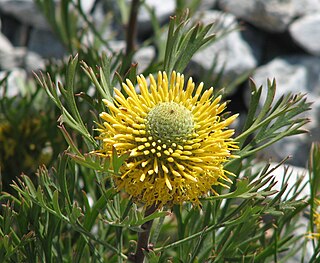
Isopogon anemonifolius, commonly known as broad-leaved drumsticks, is a shrub of the family Proteaceae that is native only to eastern New South Wales in Australia. It occurs naturally in woodland, open forest, and heathland on sandstone soils. I. anemonifolius usually ranges between one and two metres in height, and is generally smaller in exposed heathland. Its leaves are divided and narrow, though broader than those of the related Isopogon anethifolius, and have a purplish tinge during the cooler months. The yellow flowers appear during late spring or early summer and are displayed prominently. They are followed by round grey cones, which give the plant its common name drumsticks. The small hairy seeds are found in the old flower parts.
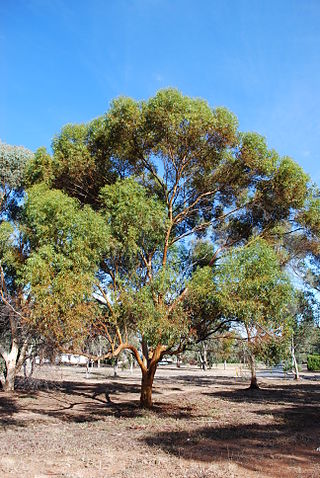
Eucalyptus salubris, commonly known as gimlet, fluted gum tree, gimlet gum and silver-topped gimlet, is a species of mallet that is endemic to low-rainfall areas of the wheatbelt and goldfields regions of Western Australia.
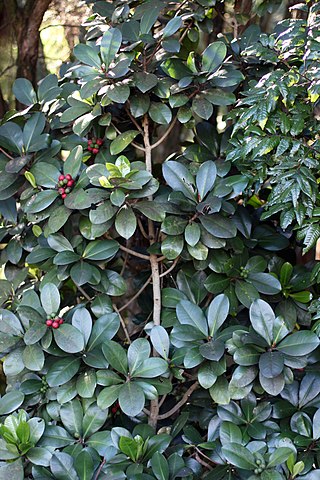
Elingamita is a genus in the plant family Primulaceae. It consists of a single species, Elingamita johnsonii, a tree or shrub endemic to the Three Kings Islands approximately 55 km north of the North Island of New Zealand. The entire world natural population of the tree is confined to a small rocky island and two nearby islets, and thus is vulnerable to destruction by fire or other unforeseen events. Elingamita johnsonii grows as a shrub or small tree in pohutukawa forest and coastal scrub on West island. It also occurs on two rocky islets of the Princes Group; on one of these islets, Hinemoa Rock, it grows as an emergent canopy tree in exposed places. The relationship of Elingamita to other genera of the Primulaceae remains to be properly established. Discovered in 1950, Elingamita johnsonii takes its name from the steamer Elingamite, which was wrecked on West Island in 1902. The natural range is currently free of rodents, but the fruit is known to be very palatable to rats.
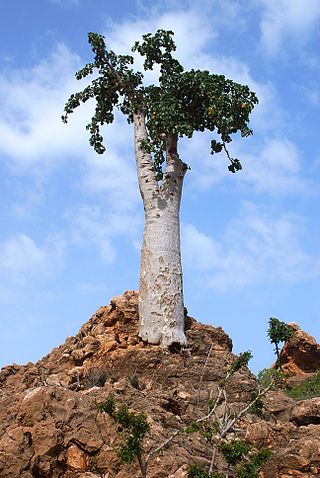
Dendrosicyos is a monotypic genus in the plant family Cucurbitaceae. The only species is Dendrosicyos socotranus, the cucumber tree. The species is endemic to the island of Socotra in Yemen, and is the only species in the Cucurbitaceae to grow in a tree form. The species name was originally spelled D. socotrana, but this is corrected to masculine grammatical gender according to the International Code of Nomenclature for algae, fungi, and plants.

Amorphophallus titanum, the titan arum, is a flowering plant in the family Araceae. It has the largest unbranched inflorescence in the world. The inflorescence of the talipot palm, Corypha umbraculifera, is larger, but it is branched rather than unbranched. A. titanum is endemic to rainforests on the Indonesian island of Sumatra.

Guazuma ulmifolia, commonly known as West Indian elm or bay cedar, is a medium-sized tree normally found in pastures and disturbed forests. This flowering plant from the family Malvaceae grows up to 30m in height and 30–40cm in diameter. It is widely found in areas such as the Caribbean, South America, Central America and Mexico serving several uses that vary from its value in carpentry to its utility in medicine.

Simarouba amara is a species of tree in the family Simaroubaceae, found in the rainforests and savannahs of South and Central America and the Caribbean. It was first described by Aubl. in French Guiana in 1775 and is one of six species of Simarouba. The tree is evergreen, but produces a new set of leaves once a year. It requires relatively high levels of light to grow and grows rapidly in these conditions, but lives for a relatively short time. In Panama, it flowers during the dry season in February and March, whereas in Costa Rica, where there is no dry season it flowers later, between March and July. As the species is dioecious, the trees are either male or female and only produce male or female flowers. The small yellow flowers are thought to be pollinated by insects, the resulting fruits are dispersed by animals including monkeys, birds and fruit-eating bats and the seeds are also dispersed by leaf cutter ants.






















